参考链接:https://blog.csdn.net/u013733326/article/details/79847918
开始之前
- 初始化参数:
1.1:使用0来初始化参数。
1.2:使用随机数来初始化参数。
1.3:使用抑梯度异常初始化参数(参见视频中的梯度消失和梯度爆炸)。 - 正则化模型:
2.1:使用二范数对二分类模型正则化,尝试避免过拟合。
2.2:使用随机删除节点的方法精简模型,同样是为了尝试避免过拟合。 - 梯度校验 :对模型使用梯度校验,检测它是否在梯度下降的过程中出现误差过大的情况。
导入相关库
import numpy as np
import matplotlib.pyplot as plt
import sklearn
import sklearn.datasets
import init_utils #第一部分,初始化
import reg_utils #第二部分,正则化
import gc_utils #第三部分,梯度校验%matplotlib inlineplt.rcParams['figure.figsize'] = (7.0, 4.0) # set default size of plots
plt.rcParams['image.interpolation'] = 'nearest'
plt.rcParams['image.cmap'] = 'gray'
初始化参数
我们在初始化之前,我们来看看我们的数据集是怎样的:
读取并绘制数据
train_X, train_Y, test_X, test_Y = init_utils.load_dataset(is_plot=True)
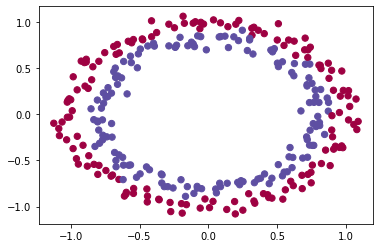
我们将要建立一个分类器把蓝点和红点分开,在之前我们已经实现过一个3层的神经网络,我们将对它进行初始化:
我们将会尝试下面三种初始化方法:
- 初始化为0
- 初始化为随机数
- 抑梯度异常初始化
模型的结构如下列代码展示:
def model(X,Y,learning_rate=0.01,num_iterations=15000,print_cost=True,initialization="he",is_polt=True):"""实现一个三层的神经网络:LINEAR ->RELU -> LINEAR -> RELU -> LINEAR -> SIGMOID参数:X - 输入的数据,维度为(2, 要训练/测试的数量)Y - 标签,【0 | 1】,维度为(1,对应的是输入的数据的标签)learning_rate - 学习速率num_iterations - 迭代的次数print_cost - 是否打印成本值,每迭代1000次打印一次initialization - 字符串类型,初始化的类型【"zeros" | "random" | "he"】is_polt - 是否绘制梯度下降的曲线图返回parameters - 学习后的参数"""grads = {
}costs = []m = X.shape[1] # 获取样本数目layers_dims = [X.shape[0],10,5,1] #隐藏层的结点数目#选择初始化参数的类型if initialization == "zeros":parameters = initialize_parameters_zeros(layers_dims)elif initialization == "random":parameters = initialize_parameters_random(layers_dims)elif initialization == "he":parameters = initialize_parameters_he(layers_dims)else : print("错误的初始化参数!程序退出")exit#开始学习for i in range(0,num_iterations):#前向传播a3 , cache = init_utils.forward_propagation(X,parameters)#计算成本 cost = init_utils.compute_loss(a3,Y)#反向传播grads = init_utils.backward_propagation(X,Y,cache)#更新参数parameters = init_utils.update_parameters(parameters,grads,learning_rate)#记录成本if i % 1000 == 0:costs.append(cost)#打印成本if print_cost:print("第" + str(i) + "次迭代,成本值为:" + str(cost))#学习完毕,绘制成本曲线if is_polt:plt.plot(costs)plt.ylabel('cost')plt.xlabel('iterations (per hundreds)')plt.title("Learning rate =" + str(learning_rate))plt.show()#返回学习完毕后的参数return parameters
初始化为零
def initialize_parameters_zeros(layers_dims):"""将模型的参数全部设置为0参数:layers_dims - 列表,模型的层数和对应每一层的节点的数量返回parameters - 包含了所有W和b的字典W1 - 权重矩阵,维度为(layers_dims[1], layers_dims[0])b1 - 偏置向量,维度为(layers_dims[1],1)···WL - 权重矩阵,维度为(layers_dims[L], layers_dims[L -1])bL - 偏置向量,维度为(layers_dims[L],1)"""parameters = {
}L = len(layers_dims) #网络层数for l in range(1,L):# 将所有的参数都设置为0parameters["W" + str(l)] = np.zeros((layers_dims[l],layers_dims[l-1]))parameters["b" + str(l)] = np.zeros((layers_dims[l],1))# 使用断言确保我的数据格式是正确的assert(parameters["W" + str(l)].shape == (layers_dims[l],layers_dims[l-1]))assert(parameters["b" + str(l)].shape == (layers_dims[l],1))return parameters
测试一下:
parameters = initialize_parameters_zeros([3,2,1])
print("W1 = " + str(parameters["W1"]))
print("b1 = " + str(parameters["b1"]))
print("W2 = " + str(parameters["W2"]))
print("b2 = " + str(parameters["b2"]))
W1 = [[0. 0. 0.][0. 0. 0.]]
b1 = [[0.][0.]]
W2 = [[0. 0.]]
b2 = [[0.]]
将所有的权重初始化为0,查看训练结果。
parameters = model(train_X, train_Y, initialization = "zeros",is_polt=True)
第0次迭代,成本值为:0.6931471805599453
第1000次迭代,成本值为:0.6931471805599453
第2000次迭代,成本值为:0.6931471805599453
第3000次迭代,成本值为:0.6931471805599453
第4000次迭代,成本值为:0.6931471805599453
第5000次迭代,成本值为:0.6931471805599453
第6000次迭代,成本值为:0.6931471805599453
第7000次迭代,成本值为:0.6931471805599453
第8000次迭代,成本值为:0.6931471805599453
第9000次迭代,成本值为:0.6931471805599453
第10000次迭代,成本值为:0.6931471805599455
第11000次迭代,成本值为:0.6931471805599453
第12000次迭代,成本值为:0.6931471805599453
第13000次迭代,成本值为:0.6931471805599453
第14000次迭代,成本值为:0.6931471805599453
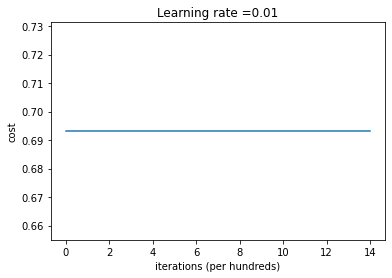
从上图中我们可以看到学习率一直没有变化,也就是说这个模型根本没有学习。我们来看看预测的结果怎么样:
print ("训练集:")
predictions_train = init_utils.predict(train_X, train_Y, parameters)
print ("测试集:")
predictions_test = init_utils.predict(test_X, test_Y, parameters)
训练集:
Accuracy: 0.5
测试集:
Accuracy: 0.5
性能确实很差,而且成本并没有真正降低,算法的性能也比随机猜测要好。为什么?让我们看看预测和决策边界的细节:
print("predictions_train = " + str(predictions_train))
print("predictions_test = " + str(predictions_test))plt.title("Model with Zeros initialization")
axes = plt.gca()
axes.set_xlim([-1.5, 1.5])
axes.set_ylim([-1.5, 1.5])
init_utils.plot_decision_boundary(lambda x: init_utils.predict_dec(parameters, x.T), train_X, train_Y)
predictions_train = [[0 0 0 0 0 0 0 0 0 0 0 0 0 0 0 0 0 0 0 0 0 0 0 0 0 0 0 0 0 0 0 0 0 0 0 00 0 0 0 0 0 0 0 0 0 0 0 0 0 0 0 0 0 0 0 0 0 0 0 0 0 0 0 0 0 0 0 0 0 0 00 0 0 0 0 0 0 0 0 0 0 0 0 0 0 0 0 0 0 0 0 0 0 0 0 0 0 0 0 0 0 0 0 0 0 00 0 0 0 0 0 0 0 0 0 0 0 0 0 0 0 0 0 0 0 0 0 0 0 0 0 0 0 0 0 0 0 0 0 0 00 0 0 0 0 0 0 0 0 0 0 0 0 0 0 0 0 0 0 0 0 0 0 0 0 0 0 0 0 0 0 0 0 0 0 00 0 0 0 0 0 0 0 0 0 0 0 0 0 0 0 0 0 0 0 0 0 0 0 0 0 0 0 0 0 0 0 0 0 0 00 0 0 0 0 0 0 0 0 0 0 0 0 0 0 0 0 0 0 0 0 0 0 0 0 0 0 0 0 0 0 0 0 0 0 00 0 0 0 0 0 0 0 0 0 0 0 0 0 0 0 0 0 0 0 0 0 0 0 0 0 0 0 0 0 0 0 0 0 0 00 0 0 0 0 0 0 0 0 0 0 0]]
predictions_test = [[0 0 0 0 0 0 0 0 0 0 0 0 0 0 0 0 0 0 0 0 0 0 0 0 0 0 0 0 0 0 0 0 0 0 0 00 0 0 0 0 0 0 0 0 0 0 0 0 0 0 0 0 0 0 0 0 0 0 0 0 0 0 0 0 0 0 0 0 0 0 00 0 0 0 0 0 0 0 0 0 0 0 0 0 0 0 0 0 0 0 0 0 0 0 0 0 0 0]]
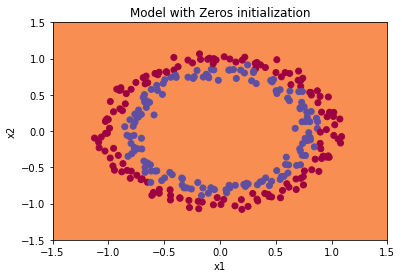
分类失败,该模型预测每个都为0。通常来说,零初始化都会导致神经网络无法打破对称性,最终导致的结果就是无论网络有多少层,最终只能得到和Logistic函数相同的效果。
随机初始化
为了打破对称性,我们可以随机地把参数赋值。在随机初始化之后,每个神经元可以开始学习其输入的不同功能。
def initialize_parameters_random(layers_dims):"""参数:layers_dims - 列表,模型的层数和对应每一层的节点的数量返回parameters - 包含了所有W和b的字典W1 - 权重矩阵,维度为(layers_dims[1], layers_dims[0])b1 - 偏置向量,维度为(layers_dims[1],1)···WL - 权重矩阵,维度为(layers_dims[L], layers_dims[L -1])b1 - 偏置向量,维度为(layers_dims[L],1)"""# 保证结果可以复现np.random.seed(3) # 指定随机种子parameters = {
}L = len(layers_dims) # 层数for l in range(1, L):# w随机初始化,b均初始化为0parameters['W' + str(l)] = np.random.randn(layers_dims[l], layers_dims[l - 1]) * 10 #使用10倍缩放parameters['b' + str(l)] = np.zeros((layers_dims[l], 1))#使用断言确保我的数据格式是正确的assert(parameters["W" + str(l)].shape == (layers_dims[l],layers_dims[l-1]))assert(parameters["b" + str(l)].shape == (layers_dims[l],1))return parameters
测试一下:
parameters = initialize_parameters_random([3, 2, 1])
print("W1 = " + str(parameters["W1"]))
print("b1 = " + str(parameters["b1"]))
print("W2 = " + str(parameters["W2"]))
print("b2 = " + str(parameters["b2"]))
W1 = [[ 17.88628473 4.36509851 0.96497468][-18.63492703 -2.77388203 -3.54758979]]
b1 = [[0.][0.]]
W2 = [[-0.82741481 -6.27000677]]
b2 = [[0.]]
查看训练结果。
parameters = model(train_X, train_Y, initialization = "random",is_polt=True)
print("训练集:")
predictions_train = init_utils.predict(train_X, train_Y, parameters)
print("测试集:")
predictions_test = init_utils.predict(test_X, test_Y, parameters)print(predictions_train)
print(predictions_test)
第0次迭代,成本值为:inf
第1000次迭代,成本值为:0.6250982793959966D:\workspace\Python\jupyter\DeepLearingAI\lecture1\lecture2\week1\init_utils.py:50: RuntimeWarning: divide by zero encountered in loglogprobs = np.multiply(-np.log(a3),Y) + np.multiply(-np.log(1 - a3), 1 - Y)
D:\workspace\Python\jupyter\DeepLearingAI\lecture1\lecture2\week1\init_utils.py:50: RuntimeWarning: invalid value encountered in multiplylogprobs = np.multiply(-np.log(a3),Y) + np.multiply(-np.log(1 - a3), 1 - Y)第2000次迭代,成本值为:0.5981216596703697
第3000次迭代,成本值为:0.5638417572298645
第4000次迭代,成本值为:0.5501703049199763
第5000次迭代,成本值为:0.5444632909664456
第6000次迭代,成本值为:0.5374513807000807
第7000次迭代,成本值为:0.4764042074074983
第8000次迭代,成本值为:0.39781492295092263
第9000次迭代,成本值为:0.3934764028765484
第10000次迭代,成本值为:0.3920295461882659
第11000次迭代,成本值为:0.38924598135108
第12000次迭代,成本值为:0.3861547485712325
第13000次迭代,成本值为:0.384984728909703
第14000次迭代,成本值为:0.3827828308349524
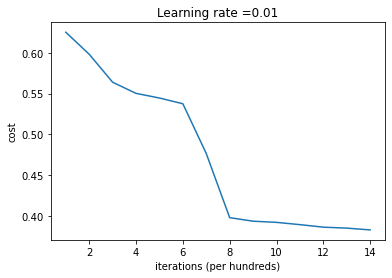
训练集:
Accuracy: 0.83
测试集:
Accuracy: 0.86
[[1 0 1 1 0 0 1 1 1 1 1 0 1 0 0 1 0 1 1 0 0 0 1 0 1 1 1 1 1 1 0 1 1 0 0 11 1 1 1 1 1 1 0 1 1 1 1 0 1 0 1 1 1 1 0 0 1 1 1 1 0 1 1 0 1 0 1 1 1 1 00 0 0 0 1 0 1 0 1 1 1 0 0 1 1 1 1 1 1 0 0 1 1 1 0 1 1 0 1 0 1 1 0 1 1 01 0 1 1 0 0 1 0 0 1 1 0 1 1 1 0 1 0 0 1 0 1 1 1 1 1 1 1 0 1 1 0 0 1 1 00 0 1 0 1 0 1 0 1 1 1 0 0 1 1 1 1 0 1 1 0 1 0 1 1 0 1 0 1 1 1 1 0 1 1 11 0 1 0 1 0 1 1 1 1 0 1 1 0 1 1 0 1 1 0 1 0 1 1 1 0 1 1 1 0 1 0 1 0 0 10 1 1 0 1 1 0 1 1 0 1 1 1 0 1 1 1 1 0 1 0 0 1 1 0 1 1 1 0 0 0 1 1 0 1 11 1 0 1 1 0 1 1 1 0 0 1 0 0 0 1 0 0 0 1 1 1 1 0 0 0 0 1 1 1 1 0 0 1 1 11 1 1 1 0 0 0 1 1 1 1 0]]
[[1 1 1 1 0 1 0 1 1 0 1 1 1 0 0 0 0 1 0 1 0 0 1 0 1 0 1 1 1 1 1 0 0 0 0 10 1 1 0 0 1 1 1 1 1 0 1 1 1 0 1 0 1 1 0 1 0 1 0 1 1 1 1 1 1 1 1 1 0 1 01 1 1 1 1 0 1 0 0 1 0 0 0 1 1 0 1 1 0 0 0 1 1 0 1 1 0 0]]
绘制出分类器图像,来查看分类结果。
plt.title("Model with large random initialization")
axes = plt.gca()
axes.set_xlim([-1.5, 1.5])
axes.set_ylim([-1.5, 1.5])
init_utils.plot_decision_boundary(lambda x: init_utils.predict_dec(parameters, x.T), train_X, train_Y)

我们可以看到误差开始很高。这是因为由于具有较大的随机权重,最后一个激活(sigmoid)输出的结果非常接近于0或1,而当它出现错误时,它会导致非常高的损失。初始化参数如果没有很好地话会导致梯度消失、爆炸,这也会减慢优化算法。如果我们对这个网络进行更长时间的训练,我们将看到更好的结果,但是使用过大的随机数初始化会减慢优化的速度。
这是因为SIGMOID函数在w很大时,梯度很小导致了下降缓慢,从而减缓了学习速度。
总而言之,将权重初始化为非常大的时候其实效果并不好,下面我们试试小一点的参数值。
抑梯度异常初始化
我们会使用到
2上一层的维度\sqrt{\frac{2}{\text{上一层的维度}}} 上一层的维度2??
这个公式来初始化参数。
def initialize_parameters_he(layers_dims):"""参数:layers_dims - 列表,模型的层数和对应每一层的节点的数量返回parameters - 包含了所有W和b的字典W1 - 权重矩阵,维度为(layers_dims[1], layers_dims[0])b1 - 偏置向量,维度为(layers_dims[1],1)···WL - 权重矩阵,维度为(layers_dims[L], layers_dims[L -1])b1 - 偏置向量,维度为(layers_dims[L],1)"""np.random.seed(3) # 指定随机种子parameters = {
}L = len(layers_dims) # 层数for l in range(1, L):# 抑梯度异常初始化parameters['W' + str(l)] = np.random.randn(layers_dims[l], layers_dims[l - 1]) * np.sqrt(2 / layers_dims[l - 1])parameters['b' + str(l)] = np.zeros((layers_dims[l], 1))#使用断言确保我的数据格式是正确的assert(parameters["W" + str(l)].shape == (layers_dims[l],layers_dims[l-1]))assert(parameters["b" + str(l)].shape == (layers_dims[l],1))return parameters
测试一下:
parameters = initialize_parameters_he([2, 4, 1])
print("W1 = " + str(parameters["W1"]))
print("b1 = " + str(parameters["b1"]))
print("W2 = " + str(parameters["W2"]))
print("b2 = " + str(parameters["b2"]))
W1 = [[ 1.78862847 0.43650985][ 0.09649747 -1.8634927 ][-0.2773882 -0.35475898][-0.08274148 -0.62700068]]
b1 = [[0.][0.][0.][0.]]
W2 = [[-0.03098412 -0.33744411 -0.92904268 0.62552248]]
b2 = [[0.]]
查看训练结果。
parameters = model(train_X, train_Y, initialization = "he",is_polt=True)
print("训练集:")
predictions_train = init_utils.predict(train_X, train_Y, parameters)
print("测试集:")
init_utils.predictions_test = init_utils.predict(test_X, test_Y, parameters)
第0次迭代,成本值为:0.8830537463419761
第1000次迭代,成本值为:0.6879825919728063
第2000次迭代,成本值为:0.6751286264523371
第3000次迭代,成本值为:0.6526117768893807
第4000次迭代,成本值为:0.6082958970572937
第5000次迭代,成本值为:0.5304944491717495
第6000次迭代,成本值为:0.4138645817071793
第7000次迭代,成本值为:0.3117803464844441
第8000次迭代,成本值为:0.23696215330322556
第9000次迭代,成本值为:0.18597287209206828
第10000次迭代,成本值为:0.15015556280371808
第11000次迭代,成本值为:0.12325079292273548
第12000次迭代,成本值为:0.09917746546525937
第13000次迭代,成本值为:0.08457055954024274
第14000次迭代,成本值为:0.07357895962677366
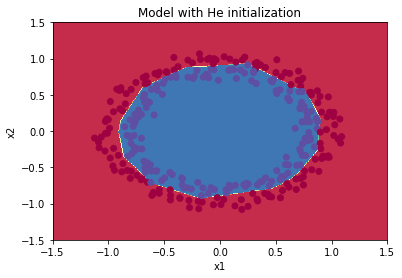
训练集:
Accuracy: 0.9933333333333333
测试集:
Accuracy: 0.96
绘制出分类器图像,来查看分类结果。
plt.title("Model with He initialization")
axes = plt.gca()
axes.set_xlim([-1.5, 1.5])
axes.set_ylim([-1.5, 1.5])
init_utils.plot_decision_boundary(lambda x: init_utils.predict_dec(parameters, x.T), train_X, train_Y)

抑梯度异常初始化的模型将蓝色和红色的点在少量的迭代中很好地分离出来。
总结一下:
- 不同的初始化方法可能导致性能最终不同
- 随机初始化有助于打破对称,使得不同隐藏层的单元可以学习到不同的参数。
- 初始化时,初始值不宜过大。
- He初始化搭配ReLU激活函数常常可以得到不错的效果。
在深度学习中,如果数据集没有足够大的话,可能会导致一些过拟合的问题。过拟合导致的结果就是在训练集上有着很高的精确度,但是在遇到新的样本时,精确度下降会很严重。为了避免过拟合的问题,接下来我们要讲解的方式就是正则化。
正则化模型
问题描述:假设你现在是一个AI专家,你需要设计一个模型,可以用于推荐在足球场中守门员将球发至哪个位置可以让本队的球员抢到球的可能性更大。说白了,实际上就是一个二分类,一半是己方抢到球,一半就是对方抢到球,我们来看一下这个图:
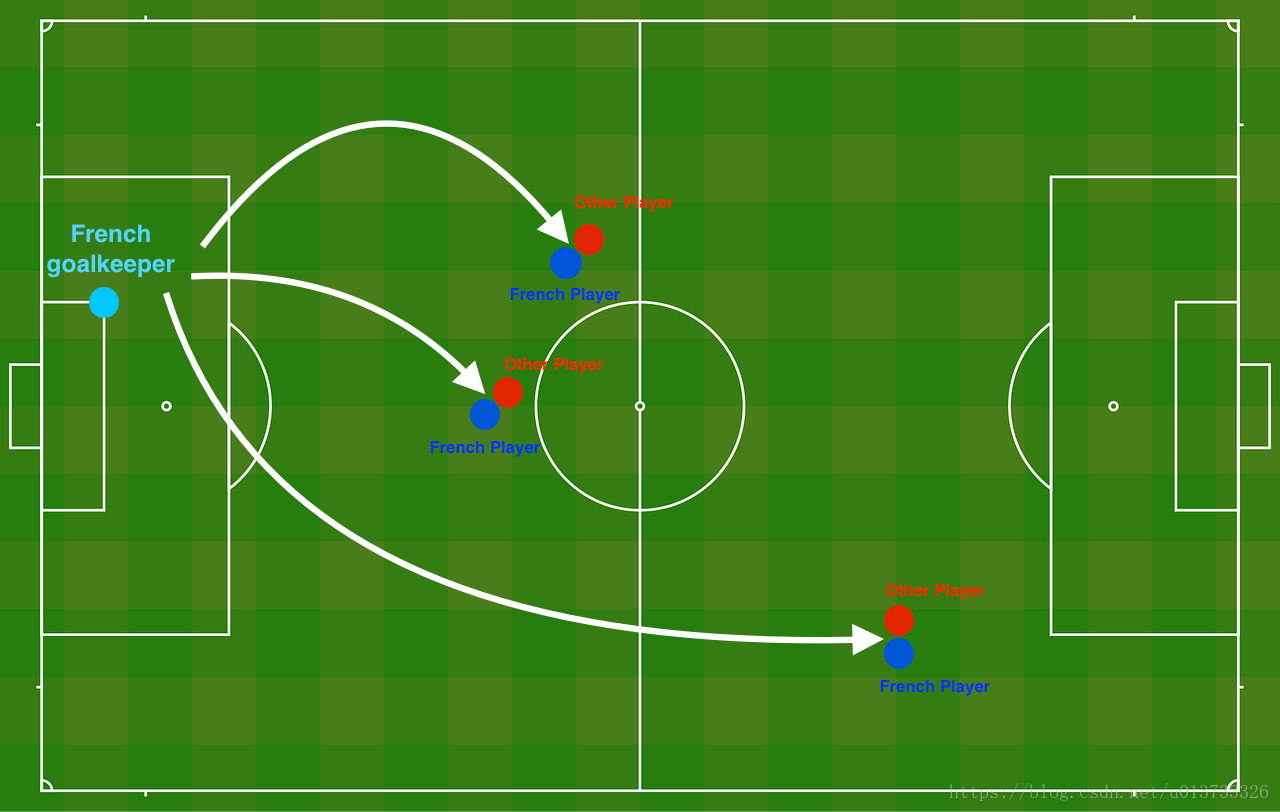
读取并绘制数据集
train_X, train_Y, test_X, test_Y = reg_utils.load_2D_dataset(is_plot=True)
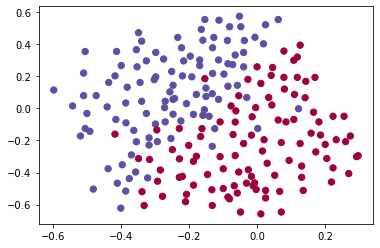
每一个点代表球落下的可能的位置,蓝色代表己方的球员会抢到球,红色代表对手的球员会抢到球,我们要做的就是使用模型来画出一条线,来找到适合我方球员能抢到球的位置。
我们要做以下三件事,来对比出不同的模型的优劣:
1.不使用正则化
2.使用正则化
2.1. 使用L2正则化
2.2. 使用随机节点删除
我们来看一下我们的模型:
- 正则化模式 - 将lambd输入设置为非零值。 我们使用“lambd”而不是“lambda”,因为“lambda”是Python中的保留关键字。
- 随机删除节点 - 将keep_prob设置为小于1的值
def model(X,Y,learning_rate=0.3,num_iterations=30000,print_cost=True,is_plot=True,lambd=0,keep_prob=1):"""实现一个三层的神经网络:LINEAR ->RELU -> LINEAR -> RELU -> LINEAR -> SIGMOID参数:X - 输入的数据,维度为(2, 要训练/测试的数量)Y - 标签,【0(蓝色) | 1(红色)】,维度为(1,对应的是输入的数据的标签)learning_rate - 学习速率num_iterations - 迭代的次数print_cost - 是否打印成本值,每迭代10000次打印一次,但是每1000次记录一个成本值is_polt - 是否绘制梯度下降的曲线图lambd - 正则化的超参数,实数keep_prob - 随机删除节点的概率返回parameters - 学习后的参数"""grads = {
} # 梯度costs = [] # 代价值m = X.shape[1] # 获取样本数量layers_dims = [X.shape[0],20,3,1] # 隐藏层单元数# 随机初始化参数parameters = reg_utils.initialize_parameters(layers_dims)#开始学习for i in range(0,num_iterations):#前向传播##是否随机删除节点if keep_prob == 1:###不随机删除节点a3 , cache = reg_utils.forward_propagation(X,parameters)elif keep_prob < 1:###随机删除节点a3 , cache = forward_propagation_with_dropout(X,parameters,keep_prob)else:print("keep_prob参数错误!程序退出。")exit#计算成本## 是否使用二范数if lambd == 0:###不使用L2正则化cost = reg_utils.compute_cost(a3,Y)else:###使用L2正则化cost = compute_cost_with_regularization(a3,Y,parameters,lambd)#反向传播##可以同时使用L2正则化和随机删除节点,但是本次实验不同时使用。assert(lambd == 0 or keep_prob ==1)##两个参数的使用情况if (lambd == 0 and keep_prob == 1):### 不使用L2正则化和不使用随机删除节点grads = reg_utils.backward_propagation(X,Y,cache)elif lambd != 0:### 使用L2正则化,不使用随机删除节点grads = backward_propagation_with_regularization(X, Y, cache, lambd)elif keep_prob < 1:### 使用随机删除节点,不使用L2正则化grads = backward_propagation_with_dropout(X, Y, cache, keep_prob)#更新参数parameters = reg_utils.update_parameters(parameters, grads, learning_rate)#记录并打印成本if i % 1000 == 0:## 记录成本costs.append(cost)if (print_cost and i % 10000 == 0):#打印成本print("第" + str(i) + "次迭代,成本值为:" + str(cost))#是否绘制成本曲线图if is_plot:plt.plot(costs)plt.ylabel('cost')plt.xlabel('iterations (x1,000)')plt.title("Learning rate =" + str(learning_rate))plt.show()#返回学习后的参数return parameters
不使用正则化
parameters = model(train_X, train_Y,is_plot=True)
print("训练集:")
predictions_train = reg_utils.predict(train_X, train_Y, parameters)
print("测试集:")
predictions_test = reg_utils.predict(test_X, test_Y, parameters)
第0次迭代,成本值为:0.6557412523481002
第10000次迭代,成本值为:0.16329987525724196
第20000次迭代,成本值为:0.13851642423253843

训练集:
Accuracy: 0.9478672985781991
测试集:
Accuracy: 0.915
绘制分割曲线
plt.title("Model without regularization")
axes = plt.gca()
axes.set_xlim([-0.75,0.40])
axes.set_ylim([-0.75,0.65])
reg_utils.plot_decision_boundary(lambda x: reg_utils.predict_dec(parameters, x.T), train_X, train_Y)
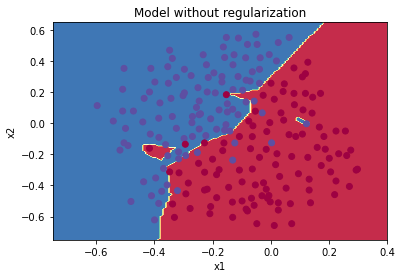
使用正则化
L2正则化
def compute_cost_with_regularization(A3,Y,parameters,lambd):"""实现公式2的L2正则化计算成本参数:A3 - 正向传播的输出结果,维度为(输出节点数量,训练/测试的数量)Y - 标签向量,与数据一一对应,维度为(输出节点数量,训练/测试的数量)parameters - 包含模型学习后的参数的字典返回:cost - 使用公式2计算出来的正则化损失的值"""m = Y.shape[1] # 样本数目# 初始化神经网络# 共三层神经网络W1 = parameters["W1"]W2 = parameters["W2"]W3 = parameters["W3"]# 计算代价值cross_entropy_cost = reg_utils.compute_cost(A3,Y)# 计算正则项的代价值L2_regularization_cost = lambd * (np.sum(np.square(W1)) + np.sum(np.square(W2)) + np.sum(np.square(W3))) / (2 * m)# 计算总的代价值cost = cross_entropy_cost + L2_regularization_costreturn cost#当然,因为改变了成本函数,我们也必须改变向后传播的函数, 所有的梯度都必须根据这个新的成本值来计算。
def backward_propagation_with_regularization(X, Y, cache, lambd):"""实现我们添加了L2正则化的模型的后向传播。参数:X - 输入数据集,维度为(输入节点数量,数据集里面的数量)Y - 标签,维度为(输出节点数量,数据集里面的数量)cache - 来自forward_propagation()的cache输出lambda - regularization超参数,实数返回:gradients - 一个包含了每个参数、激活值和预激活值变量的梯度的字典"""# 获取样本数目m = X.shape[1]# 参数初始化(Z1, A1, W1, b1, Z2, A2, W2, b2, Z3, A3, W3, b3) = cachedZ3 = A3 - Y# 后向传播的时候也加入正则项dW3 = (1 / m) * np.dot(dZ3,A2.T) + ((lambd * W3) / m )db3 = (1 / m) * np.sum(dZ3,axis=1,keepdims=True)dA2 = np.dot(W3.T,dZ3)dZ2 = np.multiply(dA2,np.int64(A2 > 0))dW2 = (1 / m) * np.dot(dZ2,A1.T) + ((lambd * W2) / m)db2 = (1 / m) * np.sum(dZ2,axis=1,keepdims=True)dA1 = np.dot(W2.T,dZ2)dZ1 = np.multiply(dA1,np.int64(A1 > 0))dW1 = (1 / m) * np.dot(dZ1,X.T) + ((lambd * W1) / m)db1 = (1 / m) * np.sum(dZ1,axis=1,keepdims=True)gradients = {
"dZ3": dZ3, "dW3": dW3, "db3": db3, "dA2": dA2,"dZ2": dZ2, "dW2": dW2, "db2": db2, "dA1": dA1, "dZ1": dZ1, "dW1": dW1, "db1": db1}return gradients
测试一下:
parameters = model(train_X, train_Y, lambd=0.7,is_plot=True)
print("使用正则化,训练集:")
predictions_train = reg_utils.predict(train_X, train_Y, parameters)
print("使用正则化,测试集:")
predictions_test = reg_utils.predict(test_X, test_Y, parameters)
第0次迭代,成本值为:0.6974484493131264
第10000次迭代,成本值为:0.2684918873282239
第20000次迭代,成本值为:0.2680916337127301
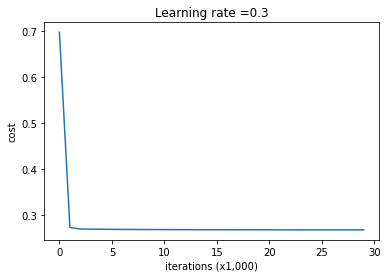
使用正则化,训练集:
Accuracy: 0.9383886255924171
使用正则化,测试集:
Accuracy: 0.93
查看分类结果
plt.title("Model with L2-regularization")
axes = plt.gca()
axes.set_xlim([-0.75,0.40])
axes.set_ylim([-0.75,0.65])
reg_utils.plot_decision_boundary(lambda x: reg_utils.predict_dec(parameters, x.T), train_X, train_Y)
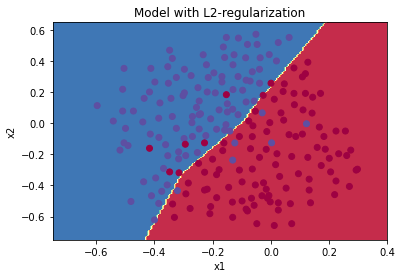
λ的值是可以使用开发集调整时的超参数。L2正则化会使决策边界更加平滑。如果λ太大,也可能会“过度平滑”,从而导致模型高偏差。L2正则化实际上在做什么?L2正则化依赖于较小权重的模型比具有较大权重的模型更简单这样的假设,因此,通过削减成本函数中权重的平方值,可以将所有权重值逐渐改变到到较小的值。权值数值高的话会有更平滑的模型,其中输入变化时输出变化更慢,但是你需要花费更多的时间。L2正则化对以下内容有影响:
- 成本计算???????: 正则化的计算需要添加到成本函数中
- 反向传播功能?????:在权重矩阵方面,梯度计算时也要依据正则化来做出相应的计算
- 重量变小(“重量衰减”)?:权重被逐渐改变到较小的值。
随机删除节点
最后,我们使用Dropout来进行正则化,Dropout的原理就是每次迭代过程中随机将其中的一些节点失效。当我们关闭一些节点时,我们实际上修改了我们的模型。背后的想法是,在每次迭代时,我们都会训练一个只使用一部分神经元的不同模型。随着迭代次数的增加,我们的模型的节点会对其他特定节点的激活变得不那么敏感,因为其他节点可能在任何时候会失效。
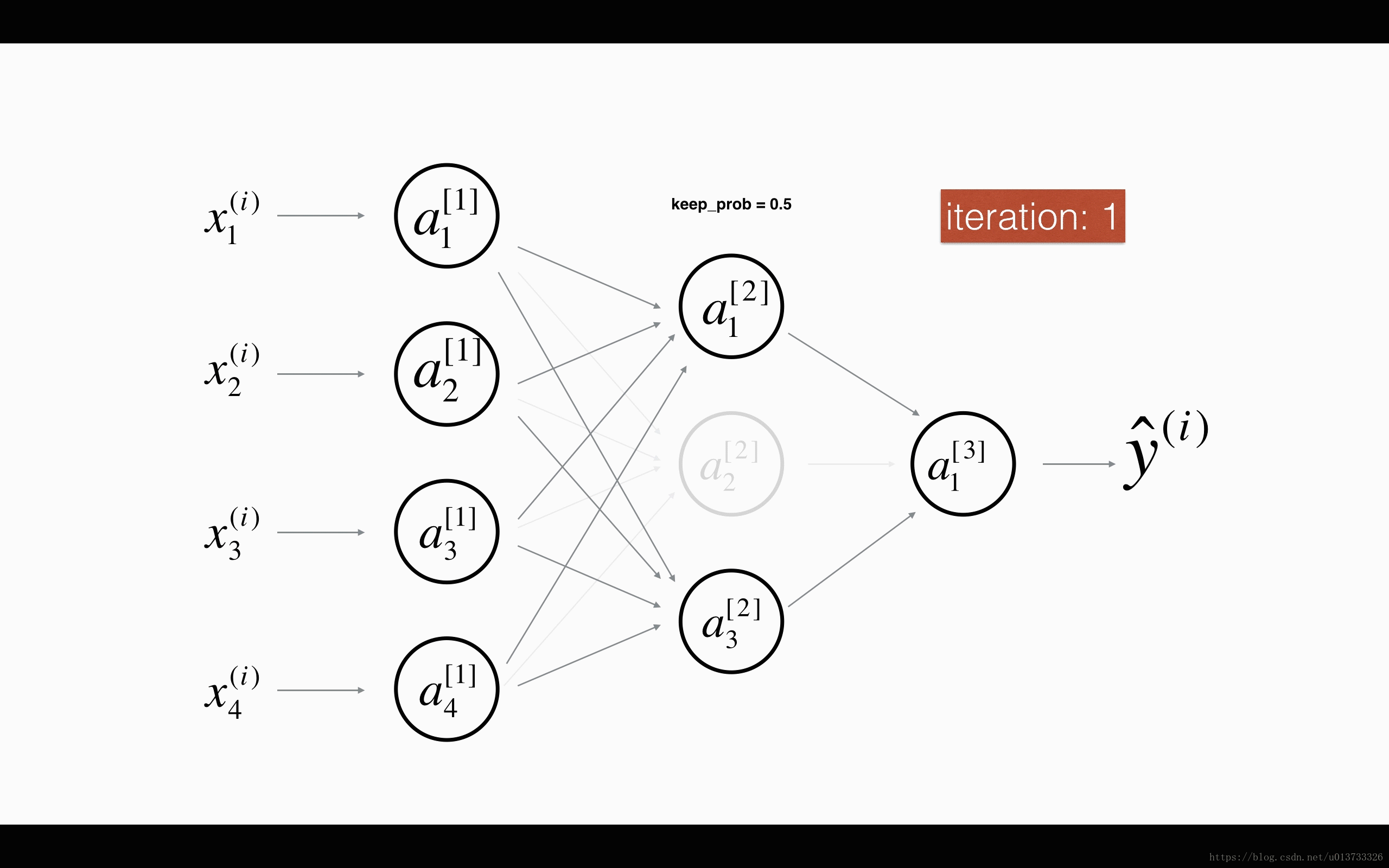
在每一次迭代中,关闭(设置为零)一层的每个神经元,概率为1 - keep_prob,我们在这里保持概率为keep_prob(这里为50%)。丢弃的节点都不参与迭代时的前向和后向传播。

下面我们将关闭第一层和第三层的一些节点,我们需要做以下四步:
1.在视频中,吴恩达老师讲解了使用np.random.rand() 来初始化和a[1] 具有相同维度的d[1],在这里,我们将使用向量化实现,我们先来实现一个和A[1]相同的随机矩阵
D[1]=[d1d1…d1]D^{[1]} = [d^{1} d^{1} … d^{1}] D[1]=[d1d1…d1]
。
2.如果
D[1]D^{[1]} D[1]
低于 (keep_prob)的值我们就把它设置为0,如果高于(keep_prob)的值我们就设置为1。
3.把
A[1]A^{[1]} A[1]
更新为
A[1]?D[1]A^{[1]} * D^{[1]} A[1]?D[1]
。 (我们已经关闭了一些节点)。我们可以使用
D[1]D^{[1]} D[1]
作为掩码。我们做矩阵相乘的时候,关闭的那些节点(值为0)就会不参与计算,因为0乘以任何值都为0。
4.使用
A[1]A^{[1]} A[1]
除以 keep_prob。这样做的话我们通过缩放就在计算成本的时候仍然具有相同的期望值,这叫做反向dropout。
def forward_propagation_with_dropout(X, parameters, keep_prob=0.5):'''实现具有随机舍弃节点的前向传播。LINEAR -> RELU + DROPOUT -> LINEAR -> RELU + DROPOUT -> LINEAR -> SIGMOID.参数:X - 输入数据集,维度为(2,示例数)parameters - 包含参数“W1”,“b1”,“W2”,“b2”,“W3”,“b3”的python字典:W1 - 权重矩阵,维度为(20,2)b1 - 偏向量,维度为(20,1)W2 - 权重矩阵,维度为(3,20)b2 - 偏向量,维度为(3,1)W3 - 权重矩阵,维度为(1,3)b3 - 偏向量,维度为(1,1)keep_prob - 随机删除的概率,实数返回:A3 - 最后的激活值,维度为(1,1),正向传播的输出cache - 存储了一些用于计算反向传播的数值的元组'''# 设置随机种子np.random.seed(1)# 初始化参数W1 = parameters['W1']b1 = parameters['b1']W2 = parameters['W2']b2 = parameters['b2']W3 = parameters['W3']b3 = parameters['b3']# LINEAR -> RELU ->LINEAR->RELU->LINEAR->SIGMOIDZ1 = np.dot(W1, X)+b1A1 = reg_utils.relu(Z1)# 下面的步骤对应上述代码的1-4# 1:初始化矩阵D1=np.random.rand()D1 = np.random.rand(A1.shape[0], A1.shape[1])# 2:将D1的值转化为0或1(用keep_prob作为阈值)D1 = D1<keep_prob # 3:舍弃A1的一些节点(将它的值变为0或者False)A1 = A1*D1# 4:缩放未舍弃的结点(不为0)的值A1 = A1/keep_probZ2 = np.dot(W2, A1)+b2A2 = reg_utils.relu(Z2)D2 = np.random.rand(A2.shape[0], A2.shape[1])# 2:将D1的值转化为0或1(用keep_prob作为阈值)D2 = D2<keep_prob # 3:舍弃A1的一些节点(将它的值变为0或者False)A2 = A2*D2# 4:缩放未舍弃的结点(不为0)的值A2 = A2/keep_probZ3 = np.dot(W3, A2)+b3A3 = reg_utils.sigmoid(Z3)cache = (Z1, D1, A1, W1, b1, Z2, D2, A2, W2, b2, Z3, A3, W3, b3)return A3, cache
更改后向传播的代码
def backward_propagation_with_dropout(X, Y, cache, keep_prob):'''实现我们随机删除的模型的后向传播。参数:X - 输入数据集,维度为(2,示例数)Y - 标签,维度为(输出节点数量,示例数量)cache - 来自forward_propagation_with_dropout()的cache输出keep_prob - 随机删除的概率,实数返回:gradients - 一个关于每个参数、激活值和预激活变量的梯度值的字典'''# 样本数目m = X.shape[1](Z1, D1, A1, W1, b1, Z2, D2, A2, W2, b2, Z3, A3, W3, b3) = cache# 反向传播dZ3 = A3-YdW3 = (1/m)*np.dot(dZ3, A2.T)db3 = 1./m*np.sum(dZ3, axis=1, keepdims=True)dA2 = np.dot(W3.T, dZ3)# 使用正向传播期间相同的节点,舍弃那些关闭的结点dA2 = dA2 * D2# 缩放为舍弃的结点(不为0)的值dA2 = dA2/keep_probdZ2 = np.multiply(dA2, np.int64(A2>0))dW2 = 1./m*np.dot(dZ2, A1.T)db2 = 1./m*np.sum(dZ2, axis=1, keepdims=True)dA1 = np.dot(W2.T, dZ2)# 使用正向传播相同的节点,舍弃那些关闭的结点dA1 = dA1*D1# 缩放未舍弃的节点(不为0)的值dA1 = dA1/keep_probdZ1 = np.multiply(dA1, np.int64(A1>0))dW1 = 1./m*np.dot(dZ1, X.T)db1 = 1./m*np.sum(dZ1, axis=1, keepdims=True)gradients = {
'dZ3':dZ3, 'dW3':dW3, 'db3':db3, 'dA2':dA2,'dZ2':dZ2, 'dW2':dW2, 'db2':db2, 'dA1':dA1,'dZ1':dZ1, 'dW1':dW1, 'db1':db1}return gradients
测试一下
parameters = model(train_X, train_Y, keep_prob=0.86, learning_rate=0.3,is_plot=True)print("使用随机删除节点,训练集:")
predictions_train = reg_utils.predict(train_X, train_Y, parameters)
print("使用随机删除节点,测试集:")
reg_utils.predictions_test = reg_utils.predict(test_X, test_Y, parameters)
第0次迭代,成本值为:0.6543912405149825D:\workspace\Python\jupyter\DeepLearingAI\lecture1\lecture2\week1\reg_utils.py:121: RuntimeWarning: divide by zero encountered in loglogprobs = np.multiply(-np.log(a3),Y) + np.multiply(-np.log(1 - a3), 1 - Y)
D:\workspace\Python\jupyter\DeepLearingAI\lecture1\lecture2\week1\reg_utils.py:121: RuntimeWarning: invalid value encountered in multiplylogprobs = np.multiply(-np.log(a3),Y) + np.multiply(-np.log(1 - a3), 1 - Y)第10000次迭代,成本值为:0.061016986574905605
第20000次迭代,成本值为:0.060582435798513114
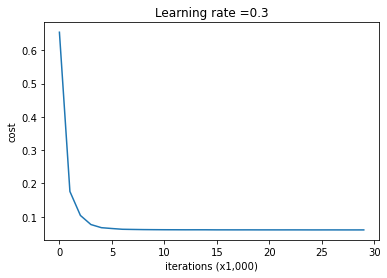
使用随机删除节点,训练集:
Accuracy: 0.9289099526066351
使用随机删除节点,测试集:
Accuracy: 0.95
查看分类情况
plt.title("Model with dropout")
axes = plt.gca()
axes.set_xlim([-0.75, 0.40])
axes.set_ylim([-0.75, 0.65])
reg_utils.plot_decision_boundary(lambda x: reg_utils.predict_dec(parameters, x.T), train_X, train_Y)

梯度校验
假设你现在是一个全球移动支付团队中的一员,现在需要建立一个深度学习模型去判断用户账户在进行付款的时候是否是被黑客入侵的。
但是,在我们执行反向传播的计算过程中,反向传播函数的计算过程是比较复杂的。为了验证我们得到的反向传播函数是否正确,现在你需要编写一些代码来验证反向传播函数的正确性。
我们先来看一下一维线性模型的梯度检查计算过程:
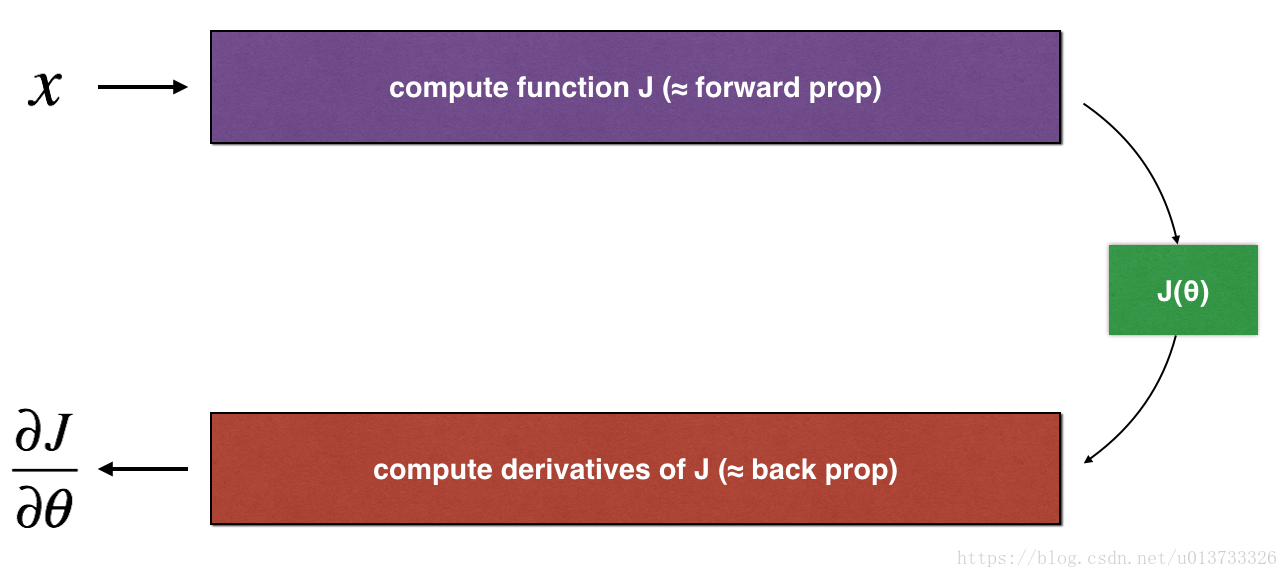
一维线性
def forward_propagation(x, theta):'''实现图中呈现的线性前向传播(计算J)(J(theta)= theta * x)参数:x - 一个实值输入theta - 参数,也是一个实数返回:J - 函数J的值,用公式J(theta)= theta * x计算'''J = np.dot(theta, x)return J
测试一下
#测试forward_propagation
print("-----------------测试forward_propagation-----------------")
x, theta = 2, 4
J = forward_propagation(x, theta)
print ("J = " + str(J))
-----------------测试forward_propagation-----------------
J = 8
反向传播
def backward_propagation(x, theta):'''计算J相对于θ的导数。参数:x - 一个实值输入theta - 参数,也是一个实数返回:dtheta - 相对于θ的成本梯度'''dtheta = xreturn dtheta
测试一下
#测试backward_propagation
print("-----------------测试backward_propagation-----------------")
x, theta = 2, 4
dtheta = backward_propagation(x, theta)
print ("dtheta = " + str(dtheta))
-----------------测试backward_propagation-----------------
dtheta = 2
梯度检查的步骤通过计算J(θ+)和J(θ-)然后计算误差,来判断我们的计算结果是否是正确的
def gradient_check(x, theta, epsilon=1e-7):'''实现图中的反向传播。参数:x - 一个实值输入theta - 参数,也是一个实数epsilon - 使用公式(3)计算输入的微小偏移以计算近似梯度返回:近似梯度和后向传播梯度之间的差异'''thetaplus = theta + epsilonthetaminus = theta - epsilonJ_plus = forward_propagation(x, thetaplus)J_minus = forward_propagation(x, thetaminus)gradapprox = (J_plus-J_minus)/(2*epsilon)# 检查gradapprox是否满足能够接近backward_propagation()的输出grad = backward_propagation(x, theta)numerator = np.linalg.norm(grad-gradapprox)denominator = np.linalg.norm(grad)+np.linalg.norm(gradapprox)difference = numerator/denominatorif difference<1e-7:print('梯度检查:梯度正常!')else:print('梯度检查:梯度超出阈值')return difference
测试一下
#测试gradient_check
print("-----------------测试gradient_check-----------------")
x, theta = 2, 4
difference = gradient_check(x, theta)
print("difference = " + str(difference))
-----------------测试gradient_check-----------------
梯度检查:梯度正常!
difference = 2.919335883291695e-10
高维参数是怎样计算的呢?我们看一下下图:
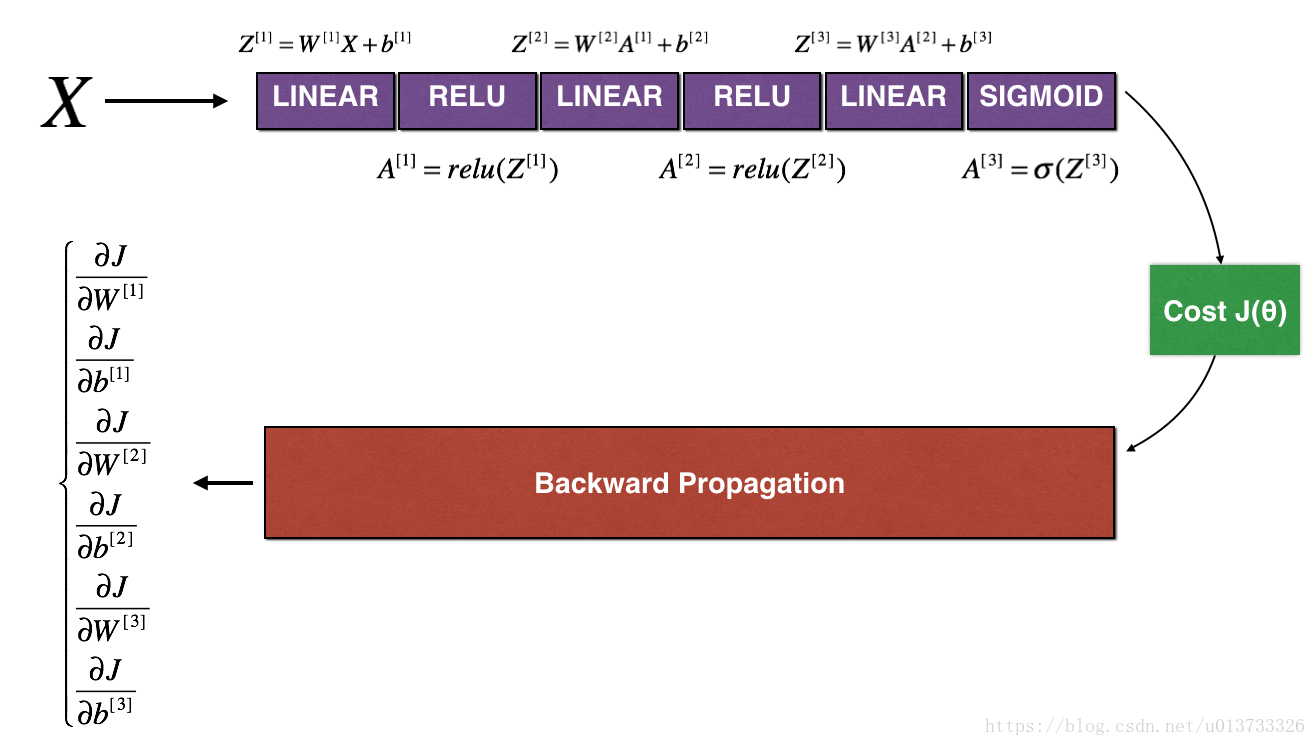
高维
def foward_propagation_n(X, Y, parameters):'''实现图中的前向传播(并计算成本)。参数:X - 训练集为m个例子Y - m个示例的标签parameters - 包含参数“W1”,“b1”,“W2”,“b2”,“W3”,“b3”的python字典:W1 - 权重矩阵,维度为(5,4)b1 - 偏向量,维度为(5,1)W2 - 权重矩阵,维度为(3,5)b2 - 偏向量,维度为(3,1)W3 - 权重矩阵,维度为(1,3)b3 - 偏向量,维度为(1,1)返回:cost - 成本函数(logistic)'''m = X.shape[1]W1 = parameters['W1']b1 = parameters['b1']W2 = parameters['W2']b2 = parameters['b2']W3 = parameters['W3']b3 = parameters['b3']# LINEAR -> RELU -> LINEAR -> RELU -> LINEAR -> SIGMOIDZ1 = np.dot(W1,X) + b1A1 = gc_utils.relu(Z1)Z2 = np.dot(W2,A1) + b2A2 = gc_utils.relu(Z2)Z3 = np.dot(W3,A2) + b3A3 = gc_utils.sigmoid(Z3)#计算成本logprobs = np.multiply(-np.log(A3), Y) + np.multiply(-np.log(1 - A3), 1 - Y)cost = (1 / m) * np.sum(logprobs)cache = (Z1, A1, W1, b1, Z2, A2, W2, b2, Z3, A3, W3, b3)return cost, cachedef backward_propagation_n(X,Y,cache):"""实现图中所示的反向传播。参数:X - 输入数据点(输入节点数量,1)Y - 标签cache - 来自forward_propagation_n()的cache输出返回:gradients - 一个字典,其中包含与每个参数、激活和激活前变量相关的成本梯度。"""m = X.shape[1](Z1, A1, W1, b1, Z2, A2, W2, b2, Z3, A3, W3, b3) = cachedZ3 = A3 - YdW3 = (1. / m) * np.dot(dZ3,A2.T)dW3 = 1. / m * np.dot(dZ3, A2.T)db3 = 1. / m * np.sum(dZ3, axis=1, keepdims=True)dA2 = np.dot(W3.T, dZ3)dZ2 = np.multiply(dA2, np.int64(A2 > 0))dW2 = 1. / m * np.dot(dZ2, A1.T)db2 = 1. / m * np.sum(dZ2, axis=1, keepdims=True)dA1 = np.dot(W2.T, dZ2)dZ1 = np.multiply(dA1, np.int64(A1 > 0))dW1 = 1. / m * np.dot(dZ1, X.T)#db1 = 4. / m * np.sum(dZ1, axis=1, keepdims=True) # Should not multiply by 4db1 = 1. / m * np.sum(dZ1, axis=1, keepdims=True)gradients = {
"dZ3": dZ3, "dW3": dW3, "db3": db3,"dA2": dA2, "dZ2": dZ2, "dW2": dW2, "db2": db2,"dA1": dA1, "dZ1": dZ1, "dW1": dW1, "db1": db1}return gradients
高维可以对每一个参数都进行梯度检查
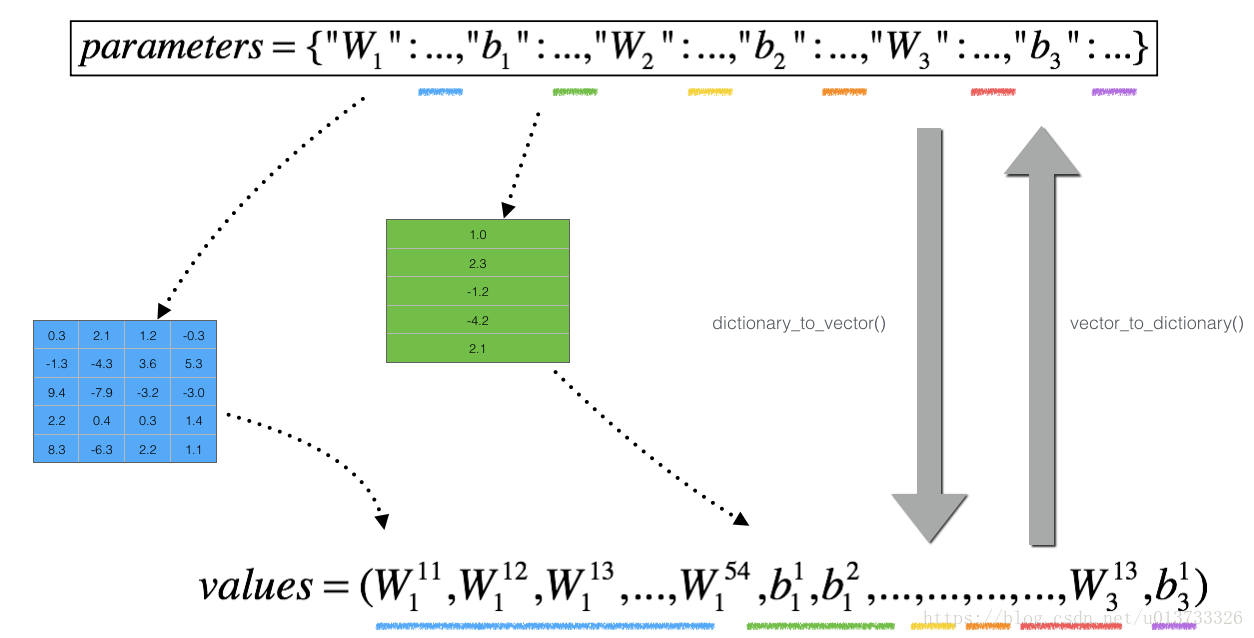
def gradient_check_n(parameters,gradients,X,Y,epsilon=1e-7):"""检查backward_propagation_n是否正确计算forward_propagation_n输出的成本梯度参数:parameters - 包含参数“W1”,“b1”,“W2”,“b2”,“W3”,“b3”的python字典gradients - grad_output_propagation_n的输出包含与参数相关的成本梯度。x - 输入数据点,维度为(输入节点数量,1)y - 标签epsilon - 计算输入的微小偏移以计算近似梯度返回:difference - 近似梯度和后向传播梯度之间的差异"""#初始化参数parameters_values , keys = gc_utils.dictionary_to_vector(parameters) #keys用不到grad = gc_utils.gradients_to_vector(gradients)# 参数数量num_parameters = parameters_values.shape[0]# 梯度检验参数初始化J_plus = np.zeros((num_parameters,1))J_minus = np.zeros((num_parameters,1))gradapprox = np.zeros((num_parameters,1))#计算gradapproxfor i in range(num_parameters):#计算J_plus [i]。输入:“parameters_values,epsilon”。输出=“J_plus [i]”thetaplus = np.copy(parameters_values) # Step 1thetaplus[i][0] = thetaplus[i][0] + epsilon # Step 2J_plus[i], cache = forward_propagation_n(X,Y,gc_utils.vector_to_dictionary(thetaplus)) # Step 3 ,cache用不到#计算J_minus [i]。输入:“parameters_values,epsilon”。输出=“J_minus [i]”。thetaminus = np.copy(parameters_values) # Step 1thetaminus[i][0] = thetaminus[i][0] - epsilon # Step 2 J_minus[i], cache = forward_propagation_n(X,Y,gc_utils.vector_to_dictionary(thetaminus))# Step 3 ,cache用不到#计算gradapprox[i]gradapprox[i] = (J_plus[i] - J_minus[i]) / (2 * epsilon)#通过计算差异比较gradapprox和后向传播梯度。numerator = np.linalg.norm(grad - gradapprox) # Step 1'denominator = np.linalg.norm(grad) + np.linalg.norm(gradapprox) # Step 2'difference = numerator / denominator # Step 3'if difference < 1e-7:print("梯度检查:梯度正常!")else:print("梯度检查:梯度超出阈值!")return difference
相关库代码
init_utils.py
# -*- coding: utf-8 -*-#init_utils.pyimport numpy as np
import matplotlib.pyplot as plt
import sklearn
import sklearn.datasetsdef sigmoid(x):"""Compute the sigmoid of xArguments:x -- A scalar or numpy array of any size.Return:s -- sigmoid(x)"""s = 1/(1+np.exp(-x))return sdef relu(x):"""Compute the relu of xArguments:x -- A scalar or numpy array of any size.Return:s -- relu(x)"""s = np.maximum(0,x)return sdef compute_loss(a3, Y):"""Implement the loss functionArguments:a3 -- post-activation, output of forward propagationY -- "true" labels vector, same shape as a3Returns:loss - value of the loss function"""m = Y.shape[1]logprobs = np.multiply(-np.log(a3),Y) + np.multiply(-np.log(1 - a3), 1 - Y)loss = 1./m * np.nansum(logprobs)return lossdef forward_propagation(X, parameters):"""Implements the forward propagation (and computes the loss) presented in Figure 2.Arguments:X -- input dataset, of shape (input size, number of examples)Y -- true "label" vector (containing 0 if cat, 1 if non-cat)parameters -- python dictionary containing your parameters "W1", "b1", "W2", "b2", "W3", "b3":W1 -- weight matrix of shape ()b1 -- bias vector of shape ()W2 -- weight matrix of shape ()b2 -- bias vector of shape ()W3 -- weight matrix of shape ()b3 -- bias vector of shape ()Returns:loss -- the loss function (vanilla logistic loss)"""# retrieve parametersW1 = parameters["W1"]b1 = parameters["b1"]W2 = parameters["W2"]b2 = parameters["b2"]W3 = parameters["W3"]b3 = parameters["b3"]# LINEAR -> RELU -> LINEAR -> RELU -> LINEAR -> SIGMOIDz1 = np.dot(W1, X) + b1a1 = relu(z1)z2 = np.dot(W2, a1) + b2a2 = relu(z2)z3 = np.dot(W3, a2) + b3a3 = sigmoid(z3)cache = (z1, a1, W1, b1, z2, a2, W2, b2, z3, a3, W3, b3)return a3, cachedef backward_propagation(X, Y, cache):"""Implement the backward propagation presented in figure 2.Arguments:X -- input dataset, of shape (input size, number of examples)Y -- true "label" vector (containing 0 if cat, 1 if non-cat)cache -- cache output from forward_propagation()Returns:gradients -- A dictionary with the gradients with respect to each parameter, activation and pre-activation variables"""m = X.shape[1](z1, a1, W1, b1, z2, a2, W2, b2, z3, a3, W3, b3) = cachedz3 = 1./m * (a3 - Y)dW3 = np.dot(dz3, a2.T)db3 = np.sum(dz3, axis=1, keepdims = True)da2 = np.dot(W3.T, dz3)dz2 = np.multiply(da2, np.int64(a2 > 0))dW2 = np.dot(dz2, a1.T)db2 = np.sum(dz2, axis=1, keepdims = True)da1 = np.dot(W2.T, dz2)dz1 = np.multiply(da1, np.int64(a1 > 0))dW1 = np.dot(dz1, X.T)db1 = np.sum(dz1, axis=1, keepdims = True)gradients = {
"dz3": dz3, "dW3": dW3, "db3": db3,"da2": da2, "dz2": dz2, "dW2": dW2, "db2": db2,"da1": da1, "dz1": dz1, "dW1": dW1, "db1": db1}return gradientsdef update_parameters(parameters, grads, learning_rate):"""Update parameters using gradient descentArguments:parameters -- python dictionary containing your parameters grads -- python dictionary containing your gradients, output of n_model_backwardReturns:parameters -- python dictionary containing your updated parameters parameters['W' + str(i)] = ... parameters['b' + str(i)] = ..."""L = len(parameters) // 2 # number of layers in the neural networks# Update rule for each parameterfor k in range(L):parameters["W" + str(k+1)] = parameters["W" + str(k+1)] - learning_rate * grads["dW" + str(k+1)]parameters["b" + str(k+1)] = parameters["b" + str(k+1)] - learning_rate * grads["db" + str(k+1)]return parametersdef predict(X, y, parameters):"""This function is used to predict the results of a n-layer neural network.Arguments:X -- data set of examples you would like to labelparameters -- parameters of the trained modelReturns:p -- predictions for the given dataset X"""m = X.shape[1]p = np.zeros((1,m), dtype = np.int)# Forward propagationa3, caches = forward_propagation(X, parameters)# convert probas to 0/1 predictionsfor i in range(0, a3.shape[1]):if a3[0,i] > 0.5:p[0,i] = 1else:p[0,i] = 0# print resultsprint("Accuracy: " + str(np.mean((p[0,:] == y[0,:]))))return pdef load_dataset(is_plot=True):np.random.seed(1)train_X, train_Y = sklearn.datasets.make_circles(n_samples=300, noise=.05)np.random.seed(2)test_X, test_Y = sklearn.datasets.make_circles(n_samples=100, noise=.05)# Visualize the dataif is_plot:plt.scatter(train_X[:, 0], train_X[:, 1], c=train_Y, s=40, cmap=plt.cm.Spectral);train_X = train_X.Ttrain_Y = train_Y.reshape((1, train_Y.shape[0]))test_X = test_X.Ttest_Y = test_Y.reshape((1, test_Y.shape[0]))return train_X, train_Y, test_X, test_Ydef plot_decision_boundary(model, X, y):# Set min and max values and give it some paddingx_min, x_max = X[0, :].min() - 1, X[0, :].max() + 1y_min, y_max = X[1, :].min() - 1, X[1, :].max() + 1h = 0.01# Generate a grid of points with distance h between themxx, yy = np.meshgrid(np.arange(x_min, x_max, h), np.arange(y_min, y_max, h))# Predict the function value for the whole gridZ = model(np.c_[xx.ravel(), yy.ravel()])Z = Z.reshape(xx.shape)# Plot the contour and training examplesplt.contourf(xx, yy, Z, cmap=plt.cm.Spectral)plt.ylabel('x2')plt.xlabel('x1')plt.scatter(X[0, :], X[1, :], c=y, cmap=plt.cm.Spectral)plt.show()def predict_dec(parameters, X):"""Used for plotting decision boundary.Arguments:parameters -- python dictionary containing your parameters X -- input data of size (m, K)Returnspredictions -- vector of predictions of our model (red: 0 / blue: 1)"""# Predict using forward propagation and a classification threshold of 0.5a3, cache = forward_propagation(X, parameters)predictions = (a3>0.5)return predictions
reg_utils.py
# -*- coding: utf-8 -*-#reg_utils.pyimport numpy as np
import matplotlib.pyplot as plt
import scipy.io as siodef sigmoid(x):"""Compute the sigmoid of xArguments:x -- A scalar or numpy array of any size.Return:s -- sigmoid(x)"""s = 1/(1+np.exp(-x))return sdef relu(x):"""Compute the relu of xArguments:x -- A scalar or numpy array of any size.Return:s -- relu(x)"""s = np.maximum(0,x)return sdef initialize_parameters(layer_dims):"""Arguments:layer_dims -- python array (list) containing the dimensions of each layer in our networkReturns:parameters -- python dictionary containing your parameters "W1", "b1", ..., "WL", "bL":W1 -- weight matrix of shape (layer_dims[l], layer_dims[l-1])b1 -- bias vector of shape (layer_dims[l], 1)Wl -- weight matrix of shape (layer_dims[l-1], layer_dims[l])bl -- bias vector of shape (1, layer_dims[l])Tips:- For example: the layer_dims for the "Planar Data classification model" would have been [2,2,1]. This means W1's shape was (2,2), b1 was (1,2), W2 was (2,1) and b2 was (1,1). Now you have to generalize it!- In the for loop, use parameters['W' + str(l)] to access Wl, where l is the iterative integer."""np.random.seed(3)parameters = {
}L = len(layer_dims) # number of layers in the networkfor l in range(1, L):parameters['W' + str(l)] = np.random.randn(layer_dims[l], layer_dims[l-1]) / np.sqrt(layer_dims[l-1])parameters['b' + str(l)] = np.zeros((layer_dims[l], 1))assert(parameters['W' + str(l)].shape == layer_dims[l], layer_dims[l-1])assert(parameters['W' + str(l)].shape == layer_dims[l], 1)return parametersdef forward_propagation(X, parameters):"""Implements the forward propagation (and computes the loss) presented in Figure 2.Arguments:X -- input dataset, of shape (input size, number of examples)Y -- true "label" vector (containing 0 if cat, 1 if non-cat)parameters -- python dictionary containing your parameters "W1", "b1", "W2", "b2", "W3", "b3":W1 -- weight matrix of shape ()b1 -- bias vector of shape ()W2 -- weight matrix of shape ()b2 -- bias vector of shape ()W3 -- weight matrix of shape ()b3 -- bias vector of shape ()Returns:loss -- the loss function (vanilla logistic loss)"""# retrieve parametersW1 = parameters["W1"]b1 = parameters["b1"]W2 = parameters["W2"]b2 = parameters["b2"]W3 = parameters["W3"]b3 = parameters["b3"]# LINEAR -> RELU -> LINEAR -> RELU -> LINEAR -> SIGMOIDz1 = np.dot(W1, X) + b1a1 = relu(z1)z2 = np.dot(W2, a1) + b2a2 = relu(z2)z3 = np.dot(W3, a2) + b3a3 = sigmoid(z3)cache = (z1, a1, W1, b1, z2, a2, W2, b2, z3, a3, W3, b3)return a3, cachedef compute_cost(a3, Y):"""Implement the cost functionArguments:a3 -- post-activation, output of forward propagationY -- "true" labels vector, same shape as a3Returns:cost - value of the cost function"""m = Y.shape[1]logprobs = np.multiply(-np.log(a3),Y) + np.multiply(-np.log(1 - a3), 1 - Y)cost = 1./m * np.nansum(logprobs)return costdef backward_propagation(X, Y, cache):"""Implement the backward propagation presented in figure 2.Arguments:X -- input dataset, of shape (input size, number of examples)Y -- true "label" vector (containing 0 if cat, 1 if non-cat)cache -- cache output from forward_propagation()Returns:gradients -- A dictionary with the gradients with respect to each parameter, activation and pre-activation variables"""m = X.shape[1](z1, a1, W1, b1, z2, a2, W2, b2, z3, a3, W3, b3) = cachedz3 = 1./m * (a3 - Y)dW3 = np.dot(dz3, a2.T)db3 = np.sum(dz3, axis=1, keepdims = True)da2 = np.dot(W3.T, dz3)dz2 = np.multiply(da2, np.int64(a2 > 0))dW2 = np.dot(dz2, a1.T)db2 = np.sum(dz2, axis=1, keepdims = True)da1 = np.dot(W2.T, dz2)dz1 = np.multiply(da1, np.int64(a1 > 0))dW1 = np.dot(dz1, X.T)db1 = np.sum(dz1, axis=1, keepdims = True)gradients = {
"dz3": dz3, "dW3": dW3, "db3": db3,"da2": da2, "dz2": dz2, "dW2": dW2, "db2": db2,"da1": da1, "dz1": dz1, "dW1": dW1, "db1": db1}return gradientsdef update_parameters(parameters, grads, learning_rate):"""Update parameters using gradient descentArguments:parameters -- python dictionary containing your parameters grads -- python dictionary containing your gradients, output of n_model_backwardReturns:parameters -- python dictionary containing your updated parameters parameters['W' + str(i)] = ... parameters['b' + str(i)] = ..."""L = len(parameters) // 2 # number of layers in the neural networks# Update rule for each parameterfor k in range(L):parameters["W" + str(k+1)] = parameters["W" + str(k+1)] - learning_rate * grads["dW" + str(k+1)]parameters["b" + str(k+1)] = parameters["b" + str(k+1)] - learning_rate * grads["db" + str(k+1)]return parametersdef load_2D_dataset(is_plot=True):data = sio.loadmat('datasets/data.mat')train_X = data['X'].Ttrain_Y = data['y'].Ttest_X = data['Xval'].Ttest_Y = data['yval'].Tif is_plot:plt.scatter(train_X[0, :], train_X[1, :], c=train_Y, s=40, cmap=plt.cm.Spectral);return train_X, train_Y, test_X, test_Ydef predict(X, y, parameters):"""This function is used to predict the results of a n-layer neural network.Arguments:X -- data set of examples you would like to labelparameters -- parameters of the trained modelReturns:p -- predictions for the given dataset X"""m = X.shape[1]p = np.zeros((1,m), dtype = np.int)# Forward propagationa3, caches = forward_propagation(X, parameters)# convert probas to 0/1 predictionsfor i in range(0, a3.shape[1]):if a3[0,i] > 0.5:p[0,i] = 1else:p[0,i] = 0# print resultsprint("Accuracy: " + str(np.mean((p[0,:] == y[0,:]))))return pdef plot_decision_boundary(model, X, y):# Set min and max values and give it some paddingx_min, x_max = X[0, :].min() - 1, X[0, :].max() + 1y_min, y_max = X[1, :].min() - 1, X[1, :].max() + 1h = 0.01# Generate a grid of points with distance h between themxx, yy = np.meshgrid(np.arange(x_min, x_max, h), np.arange(y_min, y_max, h))# Predict the function value for the whole gridZ = model(np.c_[xx.ravel(), yy.ravel()])Z = Z.reshape(xx.shape)# Plot the contour and training examplesplt.contourf(xx, yy, Z, cmap=plt.cm.Spectral)plt.ylabel('x2')plt.xlabel('x1')plt.scatter(X[0, :], X[1, :], c=y, cmap=plt.cm.Spectral)plt.show()def predict_dec(parameters, X):"""Used for plotting decision boundary.Arguments:parameters -- python dictionary containing your parameters X -- input data of size (m, K)Returnspredictions -- vector of predictions of our model (red: 0 / blue: 1)"""# Predict using forward propagation and a classification threshold of 0.5a3, cache = forward_propagation(X, parameters)predictions = (a3>0.5)return predictions
<>:63: SyntaxWarning: assertion is always true, perhaps remove parentheses?
<>:64: SyntaxWarning: assertion is always true, perhaps remove parentheses?
<>:63: SyntaxWarning: assertion is always true, perhaps remove parentheses?
<>:64: SyntaxWarning: assertion is always true, perhaps remove parentheses?
<>:63: SyntaxWarning: assertion is always true, perhaps remove parentheses?
<>:64: SyntaxWarning: assertion is always true, perhaps remove parentheses?
<ipython-input-48-93eaf45c3d38>:63: SyntaxWarning: assertion is always true, perhaps remove parentheses?assert(parameters['W' + str(l)].shape == layer_dims[l], layer_dims[l-1])
<ipython-input-48-93eaf45c3d38>:64: SyntaxWarning: assertion is always true, perhaps remove parentheses?assert(parameters['W' + str(l)].shape == layer_dims[l], 1)
gc_utils.py
# -*- coding: utf-8 -*-#gc_utils.pyimport numpy as np
import matplotlib.pyplot as pltdef sigmoid(x):"""Compute the sigmoid of xArguments:x -- A scalar or numpy array of any size.Return:s -- sigmoid(x)"""s = 1/(1+np.exp(-x))return sdef relu(x):"""Compute the relu of xArguments:x -- A scalar or numpy array of any size.Return:s -- relu(x)"""s = np.maximum(0,x)return sdef dictionary_to_vector(parameters):"""Roll all our parameters dictionary into a single vector satisfying our specific required shape."""keys = []count = 0for key in ["W1", "b1", "W2", "b2", "W3", "b3"]:# flatten parameternew_vector = np.reshape(parameters[key], (-1,1))keys = keys + [key]*new_vector.shape[0]if count == 0:theta = new_vectorelse:theta = np.concatenate((theta, new_vector), axis=0)count = count + 1return theta, keysdef vector_to_dictionary(theta):"""Unroll all our parameters dictionary from a single vector satisfying our specific required shape."""parameters = {
}parameters["W1"] = theta[:20].reshape((5,4))parameters["b1"] = theta[20:25].reshape((5,1))parameters["W2"] = theta[25:40].reshape((3,5))parameters["b2"] = theta[40:43].reshape((3,1))parameters["W3"] = theta[43:46].reshape((1,3))parameters["b3"] = theta[46:47].reshape((1,1))return parametersdef gradients_to_vector(gradients):"""Roll all our gradients dictionary into a single vector satisfying our specific required shape."""count = 0for key in ["dW1", "db1", "dW2", "db2", "dW3", "db3"]:# flatten parameternew_vector = np.reshape(gradients[key], (-1,1))if count == 0:theta = new_vectorelse:theta = np.concatenate((theta, new_vector), axis=0)count = count + 1return theta